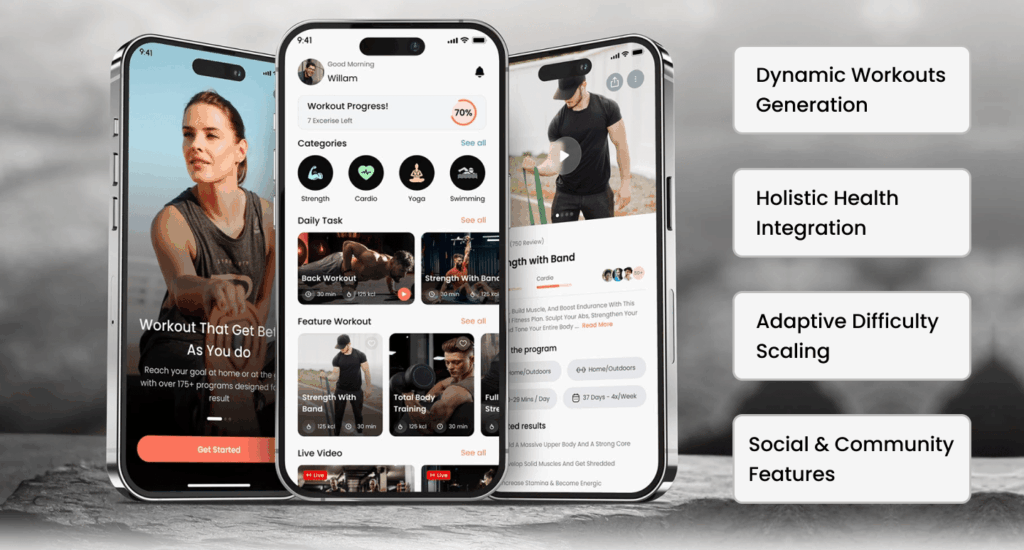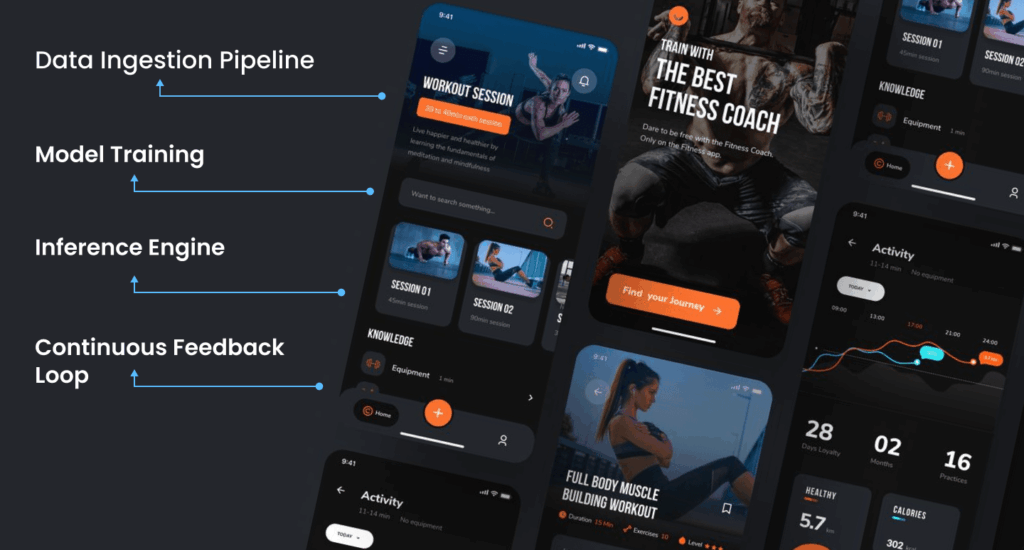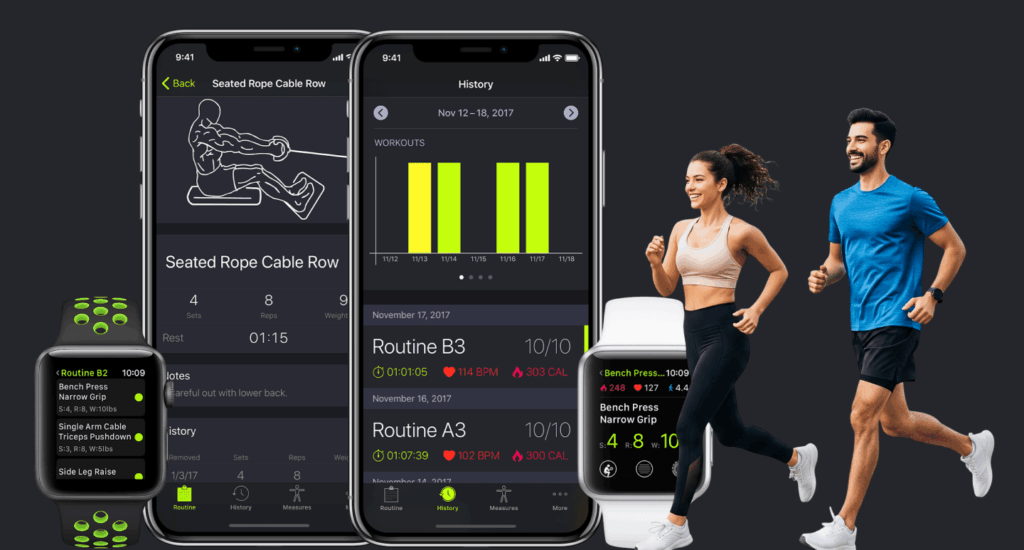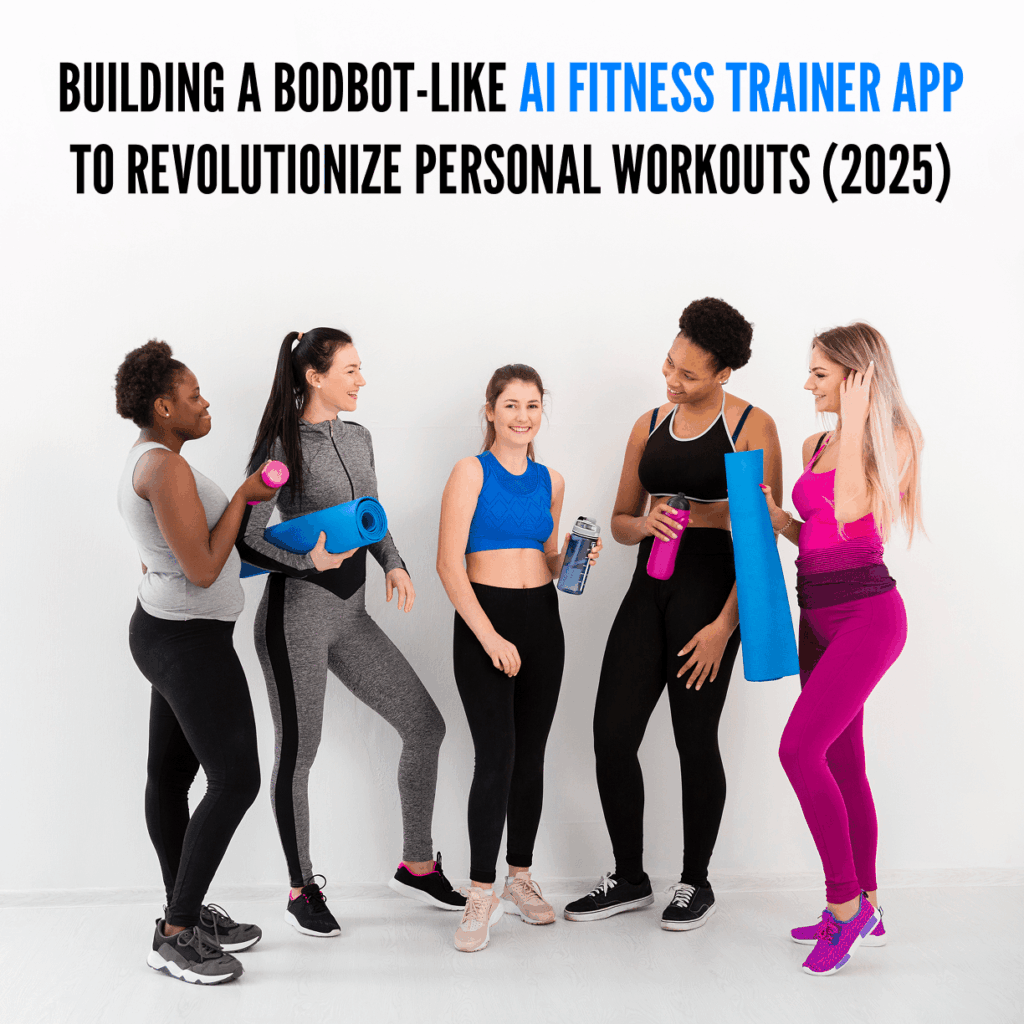|
Getting your Trinity Audio player ready...
|
In 2025, personalisation isn’t anything special. Rather, it is something that people are entitled to. The most significant focus is on fitness. Consistent, intelligent, responsive, and AI-inspired methods replace traditional, standardised workout programs. Every rep, rest, and routine is adjusted according to the individual’s needs. An AI fitness trainer application, like BodBot in the reinvented future, leaves no space between impersonal coaching and a dynamic personal assistant that engages daily according to individual performance levels, biofeedback, and goals.
The core advantage is adaptivity. Users receive workouts designed around gradually shifting capabilities and restrictions, minimizing the possibility of injury while maximizing results. There is heightened motivation because of very reliable, measurable progress. Clients also receive recovery recommendations and guidance on fatigue related to every single session, building up the body without overexertion.
Hybrid fitness solutions have become the new normal, and the demand for effective at-home solutions surged with that. With seas of wearables flooding the market and fitness tracking becoming normal, consumers are just waiting for the next change: a fully personalised, AI-driven coach that can replace a human trainer. In simple terms, fitness experiences should not only be convenient but also smarter, safer, and more sustainable.
The market opportunity is huge and will probably grow further. AI will allow personal training from the individual who goes to the gym alone to a corporate wellness program; it is such an up-and-coming area that is transitioning into a whole new way of moving, eating, sleeping, and performing.
Key Differentiators & Competitive Edge

To create a best-in-class AI fitness trainer app in 2025, you must innovate completely across multiple disciplines of intelligence, engagement, and ecosystem integration, rather than just constructing another copycat of existing platforms. Below are some points to help differentially position your solution.
Dynamic Workouts Generation
Real-time responsiveness is what distinguishes the best apps. Your AI calls on feedback from users, data from wearables, and past performance history to determine the state of the subject when generating workouts. Feeling worn out today? The AI lowers the intensity. Are you performing better than usual? The challenge goes up.
Holistic Health Integration
Fitness is just a dimension of wellness. Your application includes nutrition tracking, sleep quality, stress levels, and recovery data to classify context-aware recommendations. A bad night sleep may lead to an effortless restorative yoga routine instead of a high-intensity circuit. Suddenly, the platform moves from a workout generator to a wellness companion.
Adaptive Difficulty Scaling
The machine learning in the app detects imperceptible performance trends—deceleration of repetitions, irregularities of heart rate, and failures of form—and adjusts the difficulty scale. Users, therefore, are always challenged but never overexerted.
Social & Community Features
Gamify progress with AI-led group challenges, leaderboards, and coach interventions. Allow users to train without constraints or compete in virtual leagues. AI moderators can suggest challenges, flag streak drops, or recommend group sessions based on user behaviour.
The multi-pronged innovation strategy does create a product that feels alive through constant learning, response, and motivation. The future will be envisioned as personalised fitness.
Core AI & ML Components

Developing a really intelligent fitness training App requires a strong, responsive, resilient, and scalable AI/ML stack. Some of the components are as under:
Data Ingestion Pipeline
Data is mainly an input collected at the start of the App. The application should ingest metrics from several data sources—wearable devices (e.g., heart rate from the Apple Watch, step count from Fitbit), smartphone sensors (accelerometers, GPS), manual entries (mood and pain levels), and 3rd-party APIs (sleeping data, nutrition logs). The raw data is cleaned, labelled, and normalised in real time, ensuring that it is usable for the model.
Model Training
Different models give rise to different functionalities:
- Supervised Learning: Used for exercise recognition and form evaluation. This model is trained by labelling thousands of movement samples to learn how to differentiate between a proper squat and one that is wrong.
- Reinforcement Learning: For modifying workout plans over time, it is best. The AI is rewarded based on user engagement, progress, and goal achievements; hence, adaptive programming becomes further accurate as it is tested and used.
Inference Engine
We must strike a balance between hosting inference latency and compute efficiency. Simple inferences (like counting reps) can be handled on-device to preserve latency and privacy factors. More complex processing—trend prediction and fatigue analysis—happens on the cloud and is scaled out.
Continuous Feedback Loop
It is essential to improve at all times. The system logs user corrections, skipped exercises, ratings of sessions, and wearables’ data for fine-tuning future recommendations. This loop allows your AI to customise plans with surgical precision.
This architecture ensures that your application does not just learn once; it learns for the rest of its life. It evolves with the user, makes real-time adaptations, and learns with every session.
Wearable & Device Ecosystem Integration

To truly personalise fitness experiences, the app must provide a flawless link to an ever-growing universe of wearables and devices. Therefore, a flexible architecture must be constructed.
Multiple Device Support
Seamless pairing with popular wearables is a must. Your app needs to engage at least the Apple Watch, Fitbit, Garmin, and Oura Ring, as well as many more prominent devices via Bluetooth Low Energy (BLE). Open APIs allow the real-time synchronisation of vital statistics like heart rate, HRV, sleep cycles, and step count.
Sensor Calibration & Data Normalisation
Different devices measure different metrics in different ways. Normalisation algorithms are required to convert raw data into standardised values. For example, calibrating calorie burn between Fitbit and Garmin means users are getting the same result irrespective of the device brand.
Syncing Data While Offline
Don’t let a bad signal interrupt a workout. Allow some synchronisation of offline data and store it for later sync, so users can train anywhere—on a mountain hike or in a basement gym. Once back online, the app will sync seamlessly to cloud storage and AI engines.
Such integrations tie the AI insights to the real world and provide precision and context to every suggestion. Put simply, hardware and software need to come together and create a more intelligent training experience.
Personalised Engagement Strategies
An AI fitness app is only beneficial when the users keep coming back. Here are ways to increase long-term engagement:
Adaptive Notifications
Forget generic reminders. Use contextual triggers, such as sleep quality, inactivity patterns, or time-of-day preferences, to send relevant nudges. Celebrate milestones (“You’ve done 10 sessions this month!”) or gently nudge recovery when appropriate.
Gamification Mechanism
Make consistency a game: Introduce XP Points, Level-Ups, Daily Streaks, and Badges based on customised goals. For example, doing a full-body circuit on three consecutive days earns a badge called “Consistency Crusher.” This approach engages users and makes habits a little harder to break with a dopamine hit.
Virtual Coaching Interactions
Having a conversational AI coach builds a level of interaction similar to human interaction. Users may ask questions (“Should I increase weights today?”), get feedback on form, or get words of encouragement. Just saying, “Nice form! Let’s go for one more rep” is likely to boost immersion considerably.
These strategies, in combination, turn an app originally geared to utility alone into a habit-forming ecosystem that users feel emotionally attached to.
UX/UI Blueprint for Seamless Training
For adoption and retention, the intuitive user experience is the priority. Here is your blueprint:
Guided Session Interface
Every session should feature a clean, real-time interface, clear exercise names, video demo timers, and form cues. Overlays can highlight corrections to form using pose estimation (e.g., “Raise hips higher in plank”).
Progress Visualisations
Gamify growth on interactive dashboards. Make use of dynamic charts to show trends over time in performance: strength gains, VO2 max, sleep recovery, and so on. Let users have the visual proof of their progress.
Quick-Start Modes
At times, one just wants to move. Go for that 3-tap workflow of “Train > Upper Body > 20 Minutes”—an instant entry for a tailored workout. No scrolling, no planning—JUST GO.
Designing with clarity, friction, and intuitive automation will help you meet users where they are, both physically and mentally.
Monetisation & Retention Models
Freemium with Premium Add-ons for Users to Create Financial Viability:
Subscription Tiers
Introduce a free plan that provides access to basic AI functionalities. Unlock advanced modules, including AI coach messaging, personalised nutrition, and live form feedback, through cross-tiered subscriptions (monthly, quarterly, or yearly).
In-app Purchases
Specific add-ons targeting “marathon prep” or “postpartum core rehab” established by professionals in workouts or crafted meal plans would be sold. Users can opt for paying all at once or subscribing to bundles based on themes.
Affiliate Partnerships
Promote trusted resistance bands, kettlebells, and supplements directly from the app. AI recommendations such as “You’re doing more cardio—consider an electrolyte boost” support pertinent conversion.
Corporate Wellness Programs
License a white-label version of your application to organisations to give employers dashboards for tracking group progress and rewarding active employees, increasing revenue and visibility.
Together, these models create a diversified and scalable revenue stream harnessed around those high-value experiences.
Pilot Program & Proof-of-Concept
Conduct smart tests before expanding the program. Utilise lean methodologies to test features and gather insights for validation.
Success Metrics
Workout completion rates, daily active users (DAUs), and retention rates for weeks with qualitative metrics on session satisfaction will be monitored. Furthermore, make comparisons based on users achieving fitness goals to quantify the impact.
Pilot Cohort
Divide your users into two cohorts: fitness enthusiasts who are willing to optimise and change their lifestyles. This contrast shows how far your AI can adapt across the experience continuum.
Timeline
Run a smaller-scale pilot for 4 to 8 consecutive weeks. First week: gathering baseline metrics. Weeks 2 to 7: adaptive programming goes into action. Week 8: assessing results against goals.
Iterative Feedback Workshops
Set up weekly virtual feedback with participants, actively listening, testing tweaks, and iterating quickly. This co-creation strengthens ownership and accelerates development.
Not only does your pilot test your app, but it is also a story that investors, users, and partners want to be part of.
Cost Breakdown & Investment Plan
Trust is established through transparency. Here is an example of an estimated cost for the AI fitness trainer app:
MVP Development (USD 150K – 250K).
This includes the core AI engine for workout programming, UI design, and integration with at least two wearables like Fitbit and Apple Watch. It includes the provisions for a cloud backend along with user authentication and a basic analytics dashboard.
Full Version Development (USD 400K-700K).
Adds multi-modal health data fusion (sleep, nutrition, stress), social features (leaderboards, challenges), gamification, and AI conversational UI. It supports 5+ device integrations, an enterprise API, and multilingual capabilities.
Variable Drivers to the Cost
Scale of cost:
- Character of the model (pose-estimating/extreme-rep counting)
- Number of integrations (Garmin, Oura, etc.)
- Personalisation depth (caloric burn models, stress prediction)
Recurring Expenses
- Cloud inference & storage (~$10K/month)
- Retraining models (~$5K/month)
- Customer Support & Engaging (~$5K-$15K/month)
With a tight MVP, you will find timely entry into the marketplace. Phased investment will guide you in scaling using intelligent evidence of ROI at every stage.
Risk Management & Compliance
The processing of significant amounts of data entails great responsibility at the same time. Below are ways to enable protection for users and their platforms.
HIPAA & GDPR Compliant
Encrypt all health data in motion and at rest. Ensure that there is a definite consent path describing how data will be used. Allow a person to delete the data upon request. The system includes role-based access controls to limit internal exposure.
Liability Protectors
The onboarding flow incorporates comprehensive medical disclaimers. Persuade users to consult experts before undertaking rigorous regimens. The role of AI is that of a guide for routines but not a prescriber.
Data Protection Protocols
There is zero-trust architecture, multifactor authentication, and regular vulnerability scans. Audit trails were created to detect unauthorised access to data.
Safety and compliance should be integrated from the outset, as fitness and trust are personal aspects.
Why Esferasoft? Expertise & Delivery Model
At Esferasoft, one could say we work on fitness ecosystems rather than apps. More than a million users worldwide utilise the intelligent health and wellness platforms our team has developed. Every project benefits from in-depth specialisation—walking through motion detection models to biometric sync engines.
The AI engineers work their way through fitness-specific ML models, ranging from fatigue prediction to form correction. The UX team weaves physiological behaviours into the design of fluid interfaces targeting multiple user populations—from gym-goers to desk-bound novices.
Using an agile approach, we can develop your idea into a prototype, then build an MVP over 10-12 weeks, incorporating iterative user feedback. Esferasoft offers a delivery model that generates momentum for your vision.
Level Up Your Workouts with AI Precision

Prepared to generate your AI fitness dream?
Let’s have our first consultation free of charge, where we will chart the essential aspects of your application concerning its core features, timelines, and competitive differentiators. Whether you want to validate an idea or scale it, we will demonstrate how to succeed with it.
Consult Now at +91 772-3000-038!

